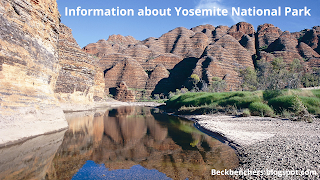Information about Yosemite National Park
Information about Yosemite National Park
Where is Yosemite National Park located? When was Yosemite National Park established? How Big is Yosemite National Park? In what year was the World Heritage Site nominated? Yosemite geological structure, Yosemite Travel Tips.
 |
| Picture: Yosemite National Park |
Where is Yosemite National Park located?
Yosemite National Park is an American national park in California, surrounded by the Sierra National Forest to the southeast and the Stanislaus National Forest to the northwest.
How Big is Yosemite National Park?
The park is operated by the National Park Service and covers an area of 7,59,620 acres (1,187 sq mi; 3,074 sq km) and covers four counties - Tuolumne and Mariposa Central, extending north and east to Mono and south to Madera County.
In what year was the World Heritage Site nominated?
Named a World Heritage Site in 1984, Yosemite is internationally recognized for its granite cliffs, waterfalls, clear streams, vast Sequoia groves, lakes, mountains, meadows, glaciers, and biodiversity. About 95% of the park is desert designated.
Yosemite is
one of the largest and least fragmented habitat blocks in Sierra Nevada, and
the park supports a variety of flora and fauna.
The park is elevated from 2,128 to 13,114 feet (648 to 3,998 m) and has five main vegetation areas: chaparral and oak forests, low mountain forests, high mountain forests, subalpine zones, and alpine.
Of the 7,000 species of plants in California, about 50% are in the Sierra Nevada and more than 20% are in Yosemite. The park has suitable habitats for more than 160 rare plants, rare local geological formations, and unique soils.
Yosemite geological structure
The geology
of the Yosemite area is characterized by granite rock and remnants of old rock.
About 10 million years ago, the Sierra Nevada developed and then tilted to form
its relatively mild western slope and more dramatic eastern slope.
Rising currents have increased the steepness of the riverbed, creating deep, narrow canyons. About a million years ago, snow and ice accumulated, forming glaciers in the high alpine meadows that moved into the river valleys.
In the early glacier stage, the ice thickness in the Yosemite Valley may have reached 4,000 feet (1,200 m). The movement of the slope beneath the ice masses cut through the U-shaped valley and sculpted what attracts many visitors today to its picturesque scenery.
When was Yosemite National Park established?
Yosemite was the focal point for the development of the national park concept. Galen Clark and others lobbied to protect the Yosemite Valley from development until in 1864 President Abraham Lincoln signed the Yosemite Grant.
By 1890, John Muir led a successful movement in Congress to establish a larger national park, with the surrounding hills and forests surrounding the valley, paving the way for a national park system.
Yosemite now attracts about four million visitors each year, and most visitors spend most of their time within seven square miles (18 sq km) of the Yosemite Valley. The park set an inspection record in 2016, surpassing 5 million visitors for the first time in its history.
In response to the increase in visitors, the park began needing reservations to enter the park during peak periods beginning in 2020.
Yosemite Travel Tips
The best time to visit Yosemite is May and September when the park is accessible, but not too crowded. It is important to note that many roads and trails in Yosemite are closed for most of the year due to snow.
So now may come in early October and come in full force in November, usually remaining until March. But stopping the blizzard in March doesn't mean the park's closed sections suddenly open their doors. Depending on the situation, not all seasonally closed roads and trails are open until May or June.
The reason why so many travelers come here during the summer months is because of the seasonal park closures, making it the busiest time of year in the park (remember packed trails, road traffic, sky-high hotel rates, and much more).
To
avoid this, it is best to travel before or after the summer rush, usually in
late May and late September.
The best
time to visit the waterfall is in late May and early June, with thunder from
freshly melted snow and the ideal cooling temperature for hiking in September
(summer temperatures can reach the 80s).
If you can only visit in the summer, be sure
to book a few months in advance. Campsites are known to acquire capabilities at
the moment they become available for booking. If you are looking for a bargain
for accommodation, winter is the best time to visit Yosemite.
Yosemite and Half Dome Village have a number of distinctive restaurants, including Pizza Patio and The Loft at Dagnan, but overall they are few in the park.
The villages
of Half Dome and Yosemite also have general and grocery stores that sell food
and hiking supplies such as camping facilities and sell dehydrated food and
water.
See more posts: Yellowstone National Park Montana



very informative
ReplyDelete